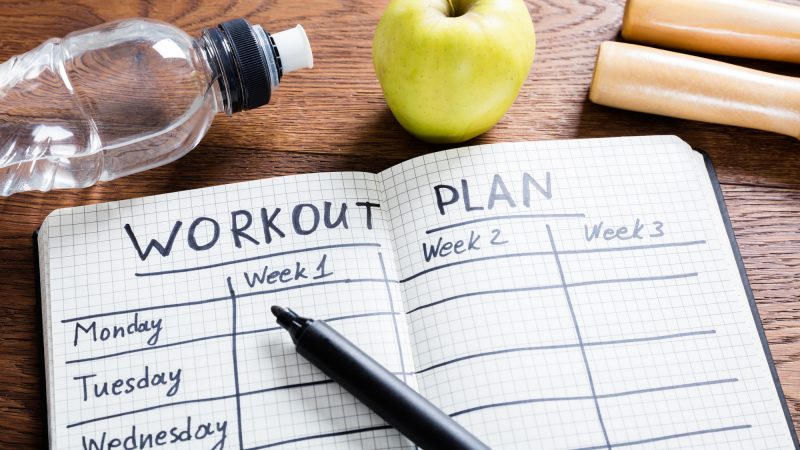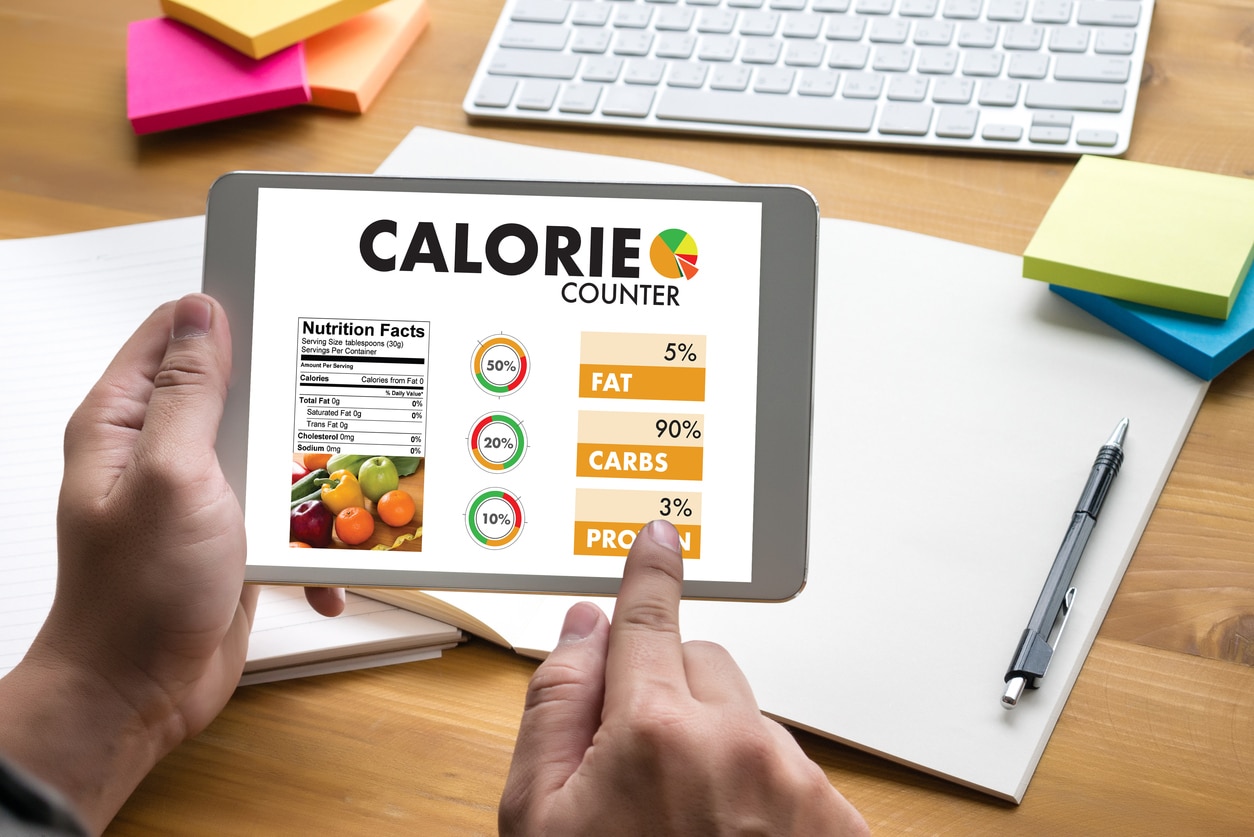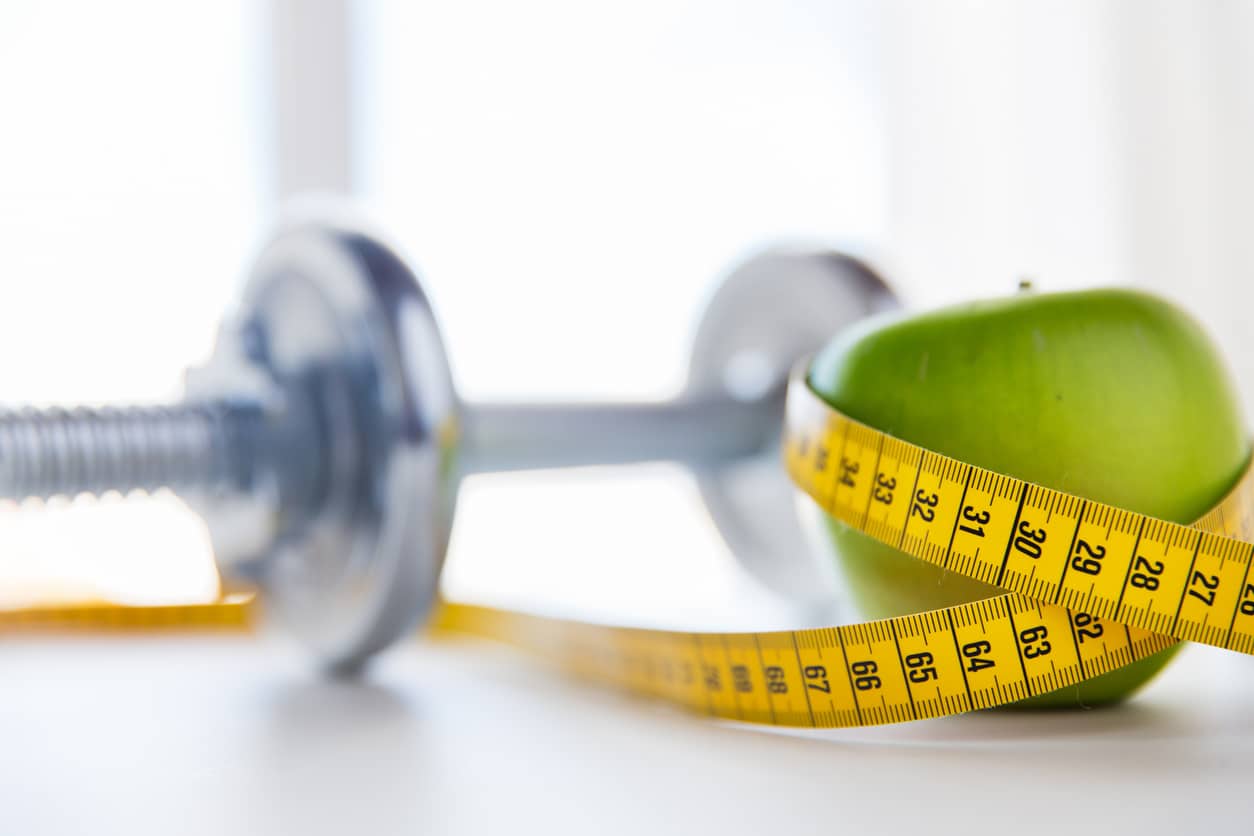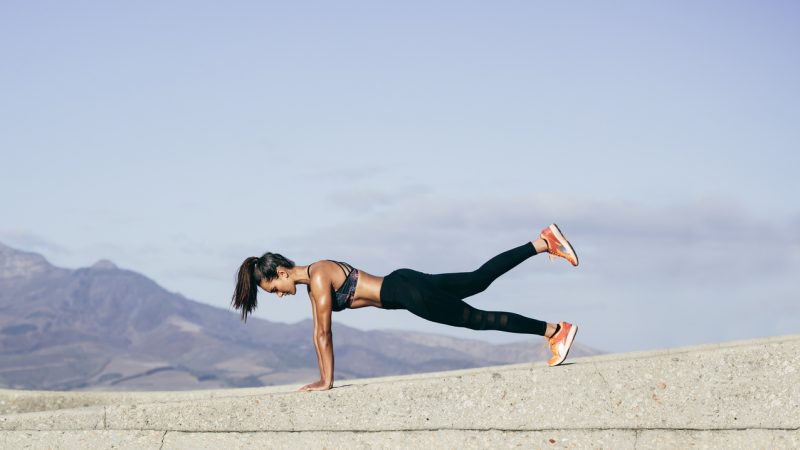Latest Posts
How To Create A Daily Exercise Plan That Works For You
How To Create A Daily Exercise Plan That Works For You
If you’ve started working out countless times but you can’t quite stick to the routine, don’t give up. Here’s how to create a daily exercise plan just for you.
Who hasn’t decided to lose weight at one point and time in their life? In the beginning, there is a lot of enthusiasm, but as time goes on it becomes harder to stay motivated. Even if you’re paying for a monthly gym membership, you may not stay the course and it becomes money down the drain.
Creating a workout plan and sticking with it requires commitment and motivation. You may want to hire a fitness trainer, but he won’t be with you seven days a week.
Asking friends and family members to hold you accountable is a good idea, but is it realistic. If they see you are not taking their encouragement to heart, you will be left to figure it out on your own.
So what is your going to do to stay focused and engaged? Continue reading for our tips on creating a daily exercise plan.
Create a Plan with Realistic Goals
The first step to make a workout plan that is suited for you is to include realistic goals. It is easy to say you will run five miles every day. But how likely are you to do it if you don’t even own running shoes?
Get real with yourself and consider goals that you can actually reach. Start small and increase exercises, repetitions and time limits as you go.
At the end of each month reassess your goals and adjust according.
Make a Personal Pledge
Creating a workout plan is a great decision. Wanting to live a healthier lifestyle is to be commended.
Before sharing your goals with others, make a commitment to yourself to reach your ultimate goal. You can do this by creating a personal pledge.
The pledge can include a mission and vision statement that outlines the reason you are on this journey. It can also include what it will mean to you to reach your ultimate goal.
Next, include a few specific things you want to commit to. Examples could include things like working out three times a week, eating healthily or losing at least five pounds a month.
Date and sign the pledge, and then place it somewhere you can see it daily. You can also be creative and decorate the pledge or place it in a unique frame.
Create a Work-out Calendar
Establishing set times to work-out can help keep you moving forward. Whether you are working out at a set time of the day, or sessions scheduled at varied times, having a calendar is a good idea. Calendars also help you stay organized.
Your calendar can be a physical paper calendar that you hang on a wall or place on your desk. It can be something on your computer or a digital calendar on your phone.
Calendars can be used to set schedules for your work-outs. You can also use it to notate that you exercised and what exercises you performed.
Make your calendar a source of motivation by writing accolades for a job well done.
Get an Accountability Partner for your Daily Exercise Plan
Accountability partners aren’t necessarily people interested in working out but should be individuals that understand the importance of doing so. It can be a friend, relative, coworker or acquaintance.
You want someone who is genuinely committed to helping you reach your goals and will be empathetic when you struggle. You do not want an accountability partner who is judgmental or will quit if you don’t reach your goals.
For the partnership to work the two of you would need to sit down and come up with a plan that is mutually acceptable. Next, you will determine effective ways to help keep you motivated and accountable to your milestones.
Keep in mind that the accountability partner is only a part of your daily exercise plan, not a requirement. If the relationship with the partner is not working, you can always find someone new. Before severing ties, make sure you are not self-sabotaging because you’re being called to task.
It doesn’t hurt to have multiple accountability partners.

Try an Exercise App
In the digital-driven world, there is an app for everything. If you have a smartphone, you can always have fitness tips and instructions at your fingertips.
Apps like Fitbit helps users track their activity, exercise, sleep, and weight. It is an ideal workout companion worth looking into.
Some work-out apps offer users a community they can connect with to share ideas. Some even offer playlists, maps, recipes, and other healthy lifestyle tips. More importantly, you have a means for automatically tracking your work-out activities.
If you are really good with apps and digital gadgets, you will want to make a comparison of the numerous apps on the market. You may find one to eliminate the need for a paper calendar and act as an accountability partner.
Join a Workout Group
Workout groups are a good way to stay motivated. They also make work-outs fun and engaging. Having the opportunity to meet new people can also lead to new friendships and openings to network professional.
Exercise groups can make a workout plan more enjoyable. They can also expose you to new ways of exercising.
When most people hear the work-out group, they immediately think of a group of people at the gym participating in exercises led by an instructor. Not today. In the world of exercise, a work-out group can mean cycling, Taekwondo or a Zumba class.
Don’t limit your search for workout groups to the local gym. Consider looking into meet-ups and other social sites that bring people together.
Incorporate New Activities
Exercise comes in many forms. At its core, it is a physical activity that promotes good health and physical fitness.
One reason people don’t stay engaged or committed to their workout plans is that they often become boring and repetitive. If you want to keep exercise exciting create a workout plan that includes multiple activities.
This is perfect for people with flexible schedules and free time in the early mornings, evenings and weekends.
Tennis
Tennis is a great way to exercise. You can get a great workout learning to play tennis if you’ve never played before. Or you can sign-up for cardio tennis, which gets the heart pumping while learning tennis drills.
Cycling
Cycling is something you can do with a partner or alone. Many cities are installing bike trails as well as making city streets bicycle safe. Purchasing a bike is an investment that will pay off in the long run.
Cycling also gets you outdoors and can take you on many adventures.
Swimming
Like tennis, swimming is an activity that has just as many benefits for the novice as it does the experienced participant. Gyms and fitness centers that have swimming pools often offer water aerobics, which is a great way to exercise.
Some local governments offer free or low-cost swimming lessons at recreation centers that have swimming pools.
These are just a few suggestions. Any sport or activity that increases your cardio can be used to keep you moving.
Plan Your Meals
Part of a successful exercise plan is monitoring what you eat. It makes no sense put all that work into exercising, losing weight and toning up, to keep the same poor eating habits.
Having a meal plan helps you monitor your calories. It also helps you keep a set schedule for your meals.
As you build your own workout plan, consider looking into meal prep. This way you have pre-planned, prepared meals that allow for portion control. With meal prep, the focus is on nutritious low-calorie meals that include a protein, starch, and vegetable.
The ultimate goal is to stay away from menus that require too many ingredients.

Take Part in a Fitness Challenge
Fitness challenges are a good way to jumpstart your daily exercise plan. These challenges are typically designed to provide everything you need from a daily schedule to menu ideas and guidance from a trained professional.
During the challenge, which usually lasts several weeks or a few months, you will learn everything you need to build your own workout plan. The fitness instructors will teach you everything you need to succeed.
Do your research ahead of time to ensure the challenge you choose is right for you and your fitness level. Don’t allow yourself to become overwhelmed by thinking the exercises or daily schedule is too advanced. Ask the trainer to recommend a different challenge.
Once you have the right plan, take what you learn from the personal fitness coaches and incorporate the techniques into a personal plan. Modify the plan to create an ongoing strategy for the fitness lifestyle you can continue going forward.
Later on, if you find yourself falling off the wagon by doing it on your own, take a moment and regroup. Don’t be afraid to return to a more structured challenge under the supervision of a fitness coach.
Make Sure You have Recovery Days
Exercise doesn’t have to be all work. Truth be told, you should have a couple of days that are not focused on specific exercise activities. When creating a workout plan always incorporate recovery days.
To some, the best thing to do on recovery days is to relax and not think about exercise. In reality, recovery days are days set aside to recover from intense activities or training.
Your recovery days can be the weekend, or they can be dispersed throughout the week. Here are two good activities that can be done on these days.
Nature Walks
If the city you live in has a good parks system, they usually include a walking trail. Set aside time to walk the trail and enjoy nature. This can also be a good out for couples to have some time together or to get the kids outside.
Nature preserves are also a good way to relax and unwind, while still partaking in low-impact exercise.
Yoga
Not only does yoga improve your mental, physical but also spiritual well-being, it also improves your flexibility and muscle strength.
Yoga is an activity you can do from the comfort of your home, at the beach or in a yoga studio. Because it can be done alone you can decide how to incorporate it into your daily exercise plan.
Dancing
Ballroom dancing, country line dancing, and Stepping are all fun activities that are also relaxing and fun. There are other dance types, but you want one that is low impact. Some dancing requires a partner so the added bonus can be a night out on the time with a loved one.
The ultimate goal of recovery days is to stay active while allowing the muscles to recover from intense workouts.
Give Yourself Accolades
As you continue on your journey celebrate your accomplishments. It’s a great motivator to keep moving forward on your journey.
Accolades can be as simple as a Post-it note attached to the bathroom mirror, stating “You Did It!” You could also buy celebratory stickers to notate the days you reach your daily goals. If every day has a sticker, reward yourself with a treat or gift.
If you have a favorite motivational saying, produce t-shirts with the quote to wear to the gym. Customize your work-out gear with personal mission statements.
Another way to stay motivated is to purchase a dream outfit. Keep it in a garment bag, but attach a letter from a loved one acknowledging your accomplishment. When you reach your goal plan an outing to wear your outfit, and then read the letter.
It’s all about motivating yourself and staying the course. Celebrate yourself whenever you can, to remain positive.
We Hope You Found These Tips Useful
Creating a daily exercise plan has many variables. Exercise is key, but there are other components that bring your healthy lifestyle full circle. Most importantly, you will need a positive state of mind and a commitment to change your overall approach to exercise, eating and goal-setting.
Our 21 Day Body Transformation Challenge combines diet and exercise to transform your look. If you want to turn heads for the right reasons, find out more here.
No More Fitness Chores: How To Enjoy Working Out For Lasting Health
No More Fitness Chores: How To Enjoy Working Out For Lasting Health
Do you actually love exercise? Probably not, and you’re not alone. Most don’t know how to enjoy working out. Here’s the secret to loving workouts for life.
Do you hate working out?
Your genes might be to blame! Studies have shown that there are some people who are genetically predisposed to hating exercise. That might help to explain why only about 20 percent of Americans meet the federal government’s recommendations for physical activity.
But you can’t put all the blame on genetics when it comes to America’s exercise problem. There are also lots of people out there who don’t have fun while exercising simply because they haven’t taken the time to learn how to enjoy working out.
If you’re one of these people, you could be missing out on all the potential benefits of establishing a regular exercise routine. You could also be cutting years off your life and skipping the chance to make yourself a more physically fit person over time.
Here are 11 tips that’ll help you snap out of it and embrace working out.
Set Fitness Goals for Yourself From the Beginning
Most people know they should get more exercise than they do. So every now and then, they’ll sign up for a gym membership and start going to the gym every day after work. Or they’ll get into the habit of going for a walk or a run at the park.
There is (obviously!) nothing wrong with trying to make a commitment to working out. But you’re going to have a heck of a time keeping up with the commitment if you don’t have any goals in mind before you begin.
Is your goal to:
- Lose the extra 20 pounds you’ve been carrying around for a few years now?
- Build up your upper body strength and core so that you don’t have back problems anymore?
- Run five miles every few days to break a sweat and break out of the monotony of spending all day in an office?
Setting goals is arguably the most important part of starting a successful workout routine. Goals will keep you on track and help you avoid running into a wall at some point when your initial motivation runs out.
It’s also important to set new goals for yourself along the way. Once you’ve lost weight, gotten stronger, and run five miles, you should push yourself to set and meet other goals. You’ll find out how to enjoy working out by taking this approach to exercise.
Start Slow and Avoid Trying to Hit All Your Goals at Once
The biggest mistake people make when they first start working out is that they often try to accomplish all the goals they set for themselves at once.
They want to lose 20 pounds in a week so they spend three hours in the gym every day. They want to be able to improve their bench press by 50 pounds after just a few workouts so they work their muscles to the point of sheer exhaustion every time they’re lifting. They want to run five miles so they run each and every day for a few weeks.
If you haven’t worked out regularly in a long time, you could put your body at real risk by overdoing it at the beginning. Your muscles and the other parts of your body aren’t ready for workouts this intense.
You’re also going to expend all your mental energy if you aren’t careful. You might reach your goals, but you could also burn out in the process and stop working out once you do. That’ll be counterproductive and won’t allow you to develop lifelong workout habits.
Start off slow instead and ease your way into working out. It’ll be better for your mind and body and motivate you to continue coming back for more.
Find Someone Who Wants to Work Out With You on a Regular Basis
If you know that you struggle to motivate yourself to go to the gym or the park to work out, it might be a good idea for you to put out feelers and find a workout buddy.
Studies have suggested that those who work out with someone else tend to work out more often and have better workouts. This is especially true when people find workout buddies who are capable of providing them with emotional support.
This doesn’t necessarily mean you just want to choose anyone to be your workout buddy. In some cases, your workout buddy might actually end up dragging you down if you have to do all the heavy lifting as far as emotional support is concerned.
Before you agree to work out regularly with a person, make sure they’re as committed to exercising as you are. Make sure they want to do similar workouts to you as well.
By teaming up with someone else, you can make it easier to get motivated to go to the gym and swap workout stories with someone who can relate to you. It’ll make working out more enjoyable for both of you and make it feel more fun.
Experiment With Different Workout Routines (and Switch Up Your Routine Regularly!)
When you first start working out on a regular basis, you’re likely going to fall into some kind of routine. Whether you’re lifting weights, running, or doing some other activity, you’re going to find yourself doing the same exercises all the time.
It’s OK to do this for a little while, but you should try to switch up your routine from time to time. It can help you:
- Steer clear of overworking certain muscles
- Strengthen muscles you’re not using now
- Breakthrough a weight loss goal you’ve been struggling to reach
- Inject some life back into your workouts
- Prevent you from simply going through the motions and not giving it your all
It’s also not a bad idea to try out different workout routines that you might not normally think to do.
For example, if you’re someone who spends a lot of time lifting weights, why not try a yoga class on for size? It could provide you with benefits like the flexibility that will help you during your regular workouts.
Or if you’re someone who spends a lot of time running, sign up for an intramural sport. It’ll build up your teamwork skills while allowing you to stay active in a different environment.
The key is to switch up your exercise routines to keep them feeling fresh. You’ll be a lot more motivated to go work out when you don’t know exactly what’s going to happen when you do.
Keep a Workout Journal
It can be difficult to see the strides you’re making when you work out on a day-to-day basis. Others around you might see that you’re looking more fit, but you yourself might not notice your improvements.
Keep track of the progress you’re making by starting a workout journal, ideally when you first start working out. Write down the different exercises you do during each workout, the number of reps you complete, and more.
This will give you something to reference back to whenever you’re feeling like your workouts aren’t making a difference. You’ll be able to see proof that your workouts are paying off and turning you into a person who is substantially more fit.
Incorporate Music and Podcasts into Your Workouts
Does it feel like there’s more music being released these days than ever before?
You’re not just imagining things! People are listening to more new music today than in years past and struggling to keep up with all of it.
If you find yourself caught in this predicament, working out is a great way to give yourself the time you need to catch up on new music. You can give the latest Lil Wayne album a spin or see what the new Twenty One Pilots record is all about.
Working out is also a great way to enjoy all the best podcasts the world has to offer. Just imagine how much more motivated you’ll be to go work out when you know you have a great podcast waiting for you.
Try Not to Focus Too Much on How Much Weight You’re Losing (or Not Losing!)
If one of your goals when it comes to working out is to lose weight, listen up. You will lose weight when you work out regularly…but it might not always happen as quickly as you want it to.
Everyone loses weight at a different rate. Some people can work out for a week and drop 10 pounds, while others can work out for a month and lose two pounds.
With this in mind, you shouldn’t make losing weight your only motivating factor. Otherwise, you could end up quitting just when you’re about to make a big breakthrough simply because you aren’t patient enough.
Focus on enjoying working out and getting better at exercising as opposed to using the scale as a barometer for how well your workouts are going.
Use Your Workouts to Reduce Any Stress You’re Feeling
It’s safe to say that just about everyone in America is stressed out to some degree right now. A 2017 study found that people are stressed out over everything from health care and the economy to crime and terrorist attacks.
Rather than allowing whatever stress you feel to gnaw at you, why not use it for good? Teach yourself to reduce your stress levels by working out and eliminating a lot of your biggest stresses.
You’ll find that you think more clearly and process stress better after a great workout. You’ll also have a more positive outlook on your life and everything in it when exercise is a major part of your life.
That alone should be enough to inspire you to continue working out over and over again once you start doing it regularly.
Reward Yourself Every Now and Then
There are a lot of sacrifices that are going to come along with working out on a regular basis.
You’re obviously going to be giving up a lot of your time to work out. You’re also going to be giving up money for gym memberships, workout gear, and more. You might even decide to start eating healthier to hit more of your fitness goals.
This is all great! And before long, it won’t even feel like you’re sacrificing anymore. You’ll be gaining so much from working out that your sacrifices will feel small compared to what you’re getting in return.
But don’t forget to reward yourself every now and then for putting in the time, effort, and money to work out. Have an extra slice of cake every now and then or take a day off if you feel like your body could use it.
Avoid Being Too Hard on Yourself If You Miss a Workout or Two
Believe it or not, there’s going to come a time when you–yes, you!–are going to miss a workout and feel guilty about it. There is an anxiety that washes over a lot of people when they’re forced to miss a workout for whatever reason.
It’s easy to beat yourself up over it. Even if you had a completely reasonable excuse for skipping the gym or a run, you’re going to convince yourself otherwise and feel awful.
Don’t worry too much about it. The great thing about exercising is that it’s about more than one or two individual workouts. It’s about committing yourself to lead a healthier lifestyle and then sticking to it over the long haul.
Just don’t let one or two missed workouts turn into one or two months of not working out. It can be tough to get back on the right track once you veer off it. So get back in the gym as soon as you can and continue living your best life.
Enroll Yourself in a Fitness Challenge
Have you tried everything else and found that you still can’t seem to muster up the strength to work out? A fitness challenge might be exactly what you need.
The 9-Week Challenge, in particular, can prove to be beneficial for those who don’t necessarily love to work out. In less than two months, you can totally transform your body by working with a fitness coach while still eating delicious food.
You’ll love the way you look and feel at the end of the challenge, and it’ll put a good foundation in place for you to continue to eat right and work out more than you did before.
Once You Know How to Enjoy Working Out, It Won’t Feel Like a Chore
It’s not as hard to learn how to enjoy working out as you might think. Even if you absolutely hate the idea of doing it now, you can transform yourself into a workout warrior in no time.
Start by setting some goals for yourself and easing your way into a routine. Then, try some different workouts and set up a workout journal, and before you know it, you’ll be a regular. It’ll turn out to be the best decision you’ve ever made.
Read our blog for more information on setting up a workout routine for yourself or contact us with any questions you might have.
Our 21 Day Body Transformation Challenge combines diet and exercise to transform your look. If you want to turn heads for the right reasons, find out more here.
Macros VS Calories: Which Should You Count For Weight Loss?
Macros VS Calories: Which Should You Count For Weight Loss
If you’re trying to lose weight by way of what you eat, you’ve heard about macros VS calories. Click here to find out what they are and which ones to count.
The holidays are coming up in a hurry. That means reconnecting with family and friends, taking pictures, and maybe even paying a visit to your old hometown.
This is the time of year when many of us panic and say, “Oh no, I can’t enjoy the holidays looking like THIS!”
No matter what your weight loss motivation might be, it starts with getting educated. If you’re scouring the internet for weight loss tips, you’ve been hit by an avalanche and you need to sift through the myths and half-truths to find your path.
One of the greatest debates about weight loss is whether it’s best to count macros vs calories. We’re putting it to rest once and for all. Here’s what you need to know.
Counting Macros Vs Calories: What Do I Need to Do to Lose Weight?
We’ll cut to the chase: to lose weight the right way, you need to do both. Your body is an atmosphere with a delicate balance, and you need to manage your overall calories as well as your macros to stimulate healthy weight loss.
To help you find that perfect balance, we’ll break it down one piece at a time.
Why Calories Matter for Weight Loss
Most people know the basic concept of weight loss. If you take in more calories than you burn, you gain weight. If you burn more calories than you take in, you lose weight. But why?
A calorie is a unit of energy that your body uses for all its functions, from basic survival to hitting the pavement for a run. Our bodies are programmed for survival in the wilderness, where we wouldn’t know when our next meal was coming.
If we have more energy than our body needs, the body stores the extra energy inside our fat cells so it can use it at a later time if we can’t get the food we need. When your body needs more energy than you’re giving it, it pulls the energy from those stored fat cells and uses it, leading to weight loss.
To put it in simple terms, you need to burn more calories than you eat in order to lose weight. That’s why counting calories is the method most people use for weight loss: because it’s easy and it can get the job done.
However, your daily calorie count doesn’t give you the full picture. As we’ll explain later, not all sources of calories are equal.
How Many Calories Should I Eat to Lose Weight?
This is the million-dollar question: if I need to eat fewer calories to lose weight, what should my limit be? As you may expect, it varies from one person to another. Here’s how to calculate your calorie goal.
1. Find Your BMR
Everyone’s body requires a different number of calories for its basic functions like digestion, maintaining a heartbeat, and more. That number is your basal metabolic rate or BMR.
Your estimated BMR depends on your height, weight, age, and gender. You can use an online BMR calculator to find your estimated BMR.
As an example, let’s use Jane Doe. She’s a 40-year-old woman who’s 66 inches tall and she weighs 180 pounds. Based on an online calculator, her BMR is 1560. In other words, if she were to lay around all day and do no activity, she would burn 1,560 calories.
2. Factor in Your Activity Level
Now that you know your BMR, you need to factor in your typical activity level to see how many total calories your body burns on an average day.
Take a look at how much exercise you get in a typical week and assign it a number on a scale of 1.2 to 1.9. If you are sedentary and do little or no activity on a daily basis, you’re a 1.2. A 1.9, on the other hand, would be a professional athlete or someone who exercises often on top of a hard labor job.
When you’ve decided where your activity level is on this scale, multiply that number by your BMR. This is called the Harris Benedict Formula. It gives you an estimate of how many calories you need to eat on a daily basis.
Let’s go back to our Jane Doe example. She does a moderate workout three times per week, so we’ll put her at a 1.5 on the activity scale. If she multiplies that by her BMR of 1560, her total daily estimated calorie usage is 2,340.
3. Calculate Your Calorie Goal
The calculations above give you the number of calories you need to eat each day to maintain your same weight. The next step is to determine how many calories you should eat in order to lose weight.
It all depends on your desired weight loss rate. In general, you need to burn about 3500 more calories than you eat to lose one pound.
Let’s assume Jane Doe wants to lose two pounds per week. That means she needs a 7,000 calorie deficit each week.
To hit that goal, Jane Doe should eat 1,000 fewer calories than she burns each day. The puts her daily calorie limit at 1,340.
Of course, that’s only part of the story. To get the results she wants, Jane Doe needs to make sure those 1,340 calories are coming from the right sources. That’s where macronutrients come into play in our nine-week weight loss challenge.
Why Macronutrients Matter for Weight Loss
Food does more than give your body energy. It also gives your body the specific nutrients it needs to perform every function you need on a daily basis. That’s why your macros are so important: they make sure your body has what it needs to function.
There are three macronutrients: carbohydrates, proteins, and fats. Each one has its own nutrients and components your body needs. The key to weight loss is making sure that your body gets enough of each macronutrient within your daily calorie goal.
Carbohydrates
Carbs have gotten a bad reputation over the years, and it’s only somewhat warranted.
Carbs are your body’s first source of energy. If you take in more carbs than your body needs, it stores the remaining carbs in your fat cells, enlarging them and causing weight gain.
If your body needs more energy than it’s getting from the carbs you’re eating, it pulls stored energy from your fat cells and you lose weight. That’s why low-carb diets are so popular. They cut to the chase and stimulate fast weight loss.
Proteins
The second key macro is protein. In the same way that people vilify carbs, they glorify protein.
They aren’t all wrong. Protein is made of amino acids, which are the building blocks for all your cells. They’re essential to healthy body functions.
Proteins are also necessary for your body to build muscle. The way you build muscle is that when you exercise, the effort creates tiny micro-tears in the muscle fibers. When your body repairs those tears with materials from protein, it makes the muscles stronger.
That brings up an important misconception: protein itself doesn’t make you build muscle and get fit. It gives your body what it needs to build muscle as a result of your exercise. You still need to work out to gain muscle.
Fats
Fat has become a dirty word, but thanks to more and more nutritional education, we’re changing that misconception. Dietary fat isn’t the same as fat in your body. If you stop eating fat, it doesn’t mean your body will burn your fat cells to replace it.
Dietary fat is your body’s second source of energy after it has depleted the carbs and before it starts burning stored energy. Fat is also a vital part of your diet because it includes nutrients your body needs to operate at its best.
The key is choosing healthy fats, like avocado and eggs instead of high-fat sweets.
How to Balance Your Macros for Weight Loss
Now you know the three macros you need each day, but how much of each one do you need?
In general, you should aim to get 40% of your daily calories from carbs, 40% from proteins, and 20% from fat.
While that sounds simple, it takes some calculation. Let’s use Jane Doe as our example. Her daily goal is 1,340 calories. That means she should get 536 calories from carbs, 536 from proteins, and 268 from fats each day.
The problem is that nutrition labels list the grams of each macro in your food, not the calories. That’s another calculation you have to do.
Each gram of carbs and proteins contains about four calories. Each gram of fat contains about nine calories. That means Jane Doe needs to eat 134 grams of carbs, 134 grams of protein, and 30 grams of fat every day.
Keep in mind that this is all based on a general weight loss goal. Depending on your specific goals, a nutritionist might suggest changing these ratios. For instance, someone who wants to build muscle while they lose weight might need more protein.
Tips for Losing Weight While Counting Calories and Macros
It’s not about choosing between counting calories or balancing your macros. You need both to lose weight while staying healthy. You might be able to lose weight without considering your macros, but you could compromise your health.
Your results also won’t be the same if you don’t keep your macros in line. If you’ve ever wondered why some people who lose weight end up toned while others don’t, the macros are a common reason.
If you’re ready to get started, here are some tips:
1. Work the Numbers
Considering how much of this blog is dedicated to math, you can see how important numbers are in getting your diet right. People who say, “I’m just going to estimate how healthy things are,” rarely reach their goals.
It’s also important to re-work your numbers every so often. As you lose weight, your BMR will change and your activity levels might change too. Re-do your calculations and your goals every month or two depending on your progress.
2. Keep It As a Work in Progress
You need to recognize that these numbers aren’t an exact science. Everyone’s body is unique in the ways and rates at which it processes calories.
Studies even show that the numbers vary based on ethnicity and weight history. Monitor your progress and don’t be afraid to adjust your goals and percentages if necessary.
As you do this, pay attention to more than the scale. Do you feel run-down all the time? Are you too weak to work out? If so, it’s time for an adjustment.
3. Use Water for All It’s Worth
To be blunt, drinking water helps you lose weight. It’s a well-known fact in the medical community, but not all dieters recognize it.
Hydration helps you have the energy to work out and stay active. In some cases, people think they’re hungry when they’re actually thirsty. If you drink water when you feel hungry, it could prevent you from eating more than you need.
In many cases, people who drink water soon before a meal also eat less food. It’s a great technique to try if you tend to overeat or if you leave the table still feeling hungry.
4. Planning, Planning, and More Planning
Chances are that on-the-fly decisions have landed you in a position to want to lose weight in the first place. It’s impossible to estimate the calories in a dish if you don’t know how it was prepared.
Hitting your calorie and macro goals require planning ahead. Plan your meals in advance to get the balance you need. If you plan to go to a restaurant, look up the nutritional information if possible and plan your meal ahead of time, based on the numbers.
5. Don’t Try to Go It Alone
This one’s crucial. Study after study has shown that people who lose weight with a partner, coach, or buddy are more successful. Look to a professional like our weight loss coaches for knowledgeable guidance and emotional support.
Losing Weight With a Plan
For most people, weight loss isn’t a “wing it” type of task. In many cases, we aren’t aware of how unhealthy our food choices are until we look at the calorie content and the macros they contain.
The key is planning ahead. Medical researchers have learned so much about macros vs calories, the way our bodies work, and what causes weight loss. The information above can help you take advantage of it.
If you’re ready to get started and begin working toward your best body today, our 21 Day Body Transformation Challenge combines diet and exercise to transform your look. If you want to turn heads for the right reasons, find out more here.
12 Brilliant Gym Tips For A More Efficient Workout
12 Brilliant Gym Tips For A More Efficient Workout
Do you think you’re wasting time at the gym? Efficient workouts equal fewer excuses. Here are some gym tips to help you trim the fat off your workout routine.
Do you workout regularly? If so, you’re already in an elite group.
According to new research, although more than 75% of people claim they want to get in shape and look great, only 31% actually make exercise a routine habit.
Yet, are you getting the most from your time at the gym? Do you leave with sweat dripping, adrenaline pumping and those exertion-fueled endorphins running in your veins? Or, are you still struggling to see the results you crave?
If it’s the latter, you’ve come to the right place. Today, we’re sharing 12 simple gym tips that can help you supercharge your workouts and bump up the ROI on that membership.
Ready to learn more? Let’s get started!
1. Start with a Plan
You walk into the gym and take a long look around. There are treadmills on one wall, ellipticals on another and a giant weightlifting area. It’s inspiring. It’s exciting. It’s also incredibly overwhelming.
You spend more than a few minutes figuring out which area you want to visit first and which part of your workout you want to prioritize.
Does this scenario sound familiar?
If so, try planning out your next gym workout. Before you even get in the car and head out, jot down what you want to focus on, how long you want to spend there and in what order you’re going to tackle it all.
Doing so not only helps you stay organized and start your workout quicker. It also makes sure your heart rate doesn’t drop as you spend time perusing the options. One way to ensure you’re always ready to go? Have a backup plan ready in case the machines you want are full.
2. Shorten and Strengthen Your Workouts
It seems like simple logic: The longer you workout, the better you’ll look and feel, right?
Not quite.
If your usual gym session includes exercising for an hour or two at a slow, moderate pace, it’s time to kick it up a notch. Studies show that interval training, or working out in smaller, 10-30 minute bursts with rests in between, is more beneficial than marathon sweat sessions.
Why? You’ll increase your heart rate, build your endurance and maximize your speed when you focus on working your body to its top capacity. When you go for longer, something has to give and it’s usually your body’s performance.
So, the next time you’re looking at the indoor track and dreading that five-mile stretch you’ve been doing, try tackling one mile instead and see how much more powerful you feel.
High-Intensity Interval Training
A popular way to add shorter, more powerful workouts to your gym routine is to try high-intensity interval training or HIIT training. Put simply, this is the method of dividing your overall workout into blocks of intense exertion along with designated times for rest.
Focus on exercises that get your heart rate and lungs working to their top capacity, and sustain the movements for a few minutes at a time. Of course, if you have any cardio or health concerns, talk to your doctor before trying a HIIT routine. It is also recommended against for those just starting out in their fitness routine.
3. Add Protein
After an especially exhausting workout, your muscles need to rebuild themselves. This is true for both cardio-centric exercises as well as strength-building ones. To amplify the results you’ll see and improve your body’s ability to bounce back, it can be helpful to add an element of protein into your post-workout meal or snack.
A simple protein shake, made with either whey or soy, is a great way to recharge and refuel after your time at the gym. You can also find protein bars and other snacks that make refilling on the go both simple and quick.
While you sip or munch, you’ll be helping your body repair any damage it sustained during your workout. You’ll also give your immune system a boost, rebuild your stored glycogen, and regrow your muscles. It’s a simple trick that can cap off a great session and help you see results quicker.
4. Pump the Right Tunes
It might sound unimportant, but the idea that the right music can affect your workout is backed by science.
While there is no one-size-fits-all playlist that will make you magically grow those muscles you want, your best bet is to stick to jams that make you feel seriously inspired. From the soundtrack to Space Jam to Madonna, anything goes. One rule? If it puts you to sleep or makes you want to cry, save it for another time.
Instead, invest in a great pair of workout headphones and turn up the dial on those energy-infused rockers that make you want to holler, howl and show your strength. Start the playlist while you’re on the way to the gym and let that feeling follow you.
5. Do a Digital Detox
One surefire way to get less from your workout? Hop off the treadmill every five minutes to respond to that group chat, take a picture of your gear or post on social media.
Not only are you allowing your heart rate to fluctuate as you momentarily disengage, but you’re also losing that valuable mental focus. If you must have your phone on you, activate airplane or vibrate mode. Otherwise, leave it in the locker room.
6. Know Your Weights
You might be tempted to grab the heaviest weight at the gym to push yourself and look cool, but take a step back from those dumbells.
Using a too-heavy weight is just as ineffective as using one that’s too light. When you try to lift a boulder, chances are you can’t do many repetitions, if any at all. The ones you are able to manage are likely not executed properly.
On the other hand, a too-small weight isn’t activating your muscles effectively. The key is to find that sweet spot. Ideally, you want a weight that requires effort to lift and move but isn’t uncomfortable to curl.
It might take some trial and error but look for one that allows you to finish out your rep set. You want to challenged and struggling just a bit on the last few reps, but not throughout.
7. Journal Your Workouts
Just as a dieter monitors what he or she eats, if you want to get the most from your gym exercises, it’s helpful to write down your progress.
Keep track of when you exercised, what you did and how you felt. You might keep your notes in an old-fashioned notebook or on a fitness app. Either way, be specific. Note how many reps you did, what weights you used and any other important details.
When you go back the next time, take a look at your notes and see where you can push yourself a little. Add a few more reps, use a slightly heavier weight or incorporate a new machine you haven’t used yet.
8. Focus on Compound Movements
Wondering what to do at the gym? Your best bet is to find exercises that pull double or triple duty.
Known as compound movements, these are ones that work for more than one muscle group at a time and at least two of your joints. While there is a time and place for bicep curls and other routines that laser-focus on one area, compound workouts are a great way to maximize your time.
As you do these moves, you’ll build muscle mass, exert more energy, and burn more calories. Not sure where to start? Try a simple lunge or squat. Or, take that bicep curl a step further and flow into a shoulder press.
9. Find an Exercise You Love
It sounds simple, but one of our best workout tips is to find a workout routine you actually enjoy doing. If you aren’t passionate about something, your initial enthusiasm will only take you so far. After that, you’re just going through the motions, often to no avail.
Our interests and goals change over time, so don’t be afraid to reexamine your routine every so often to make sure it’s still enjoyable.
Whether you love running, biking, hiking, lifting or anything in between, find a workout that brings you alive both physically and mentally. That’s the only way to ensure you stick with it in the long run.
Still, need a little motivation to summit that mountain ahead of you? Try reaching out to a personal challenge coach who can encourage you to push ahead on your fitness journey.

10. Fine-Tune Your Form
All the repetitions in the world won’t give you results if you’re not doing them correctly. While it’s fine to add on more weight as you grow stronger, make sure you’re not sacrificing your form as you do so.
This is where a personal trainer can be valuable. Work with one at your gym to make sure you’re performing each exercise the right way. Doing so can help you prevent injury and safely engage all the muscles you’re supposed to be working.
While you’re still learning, stick with a lighter weight and focus on maneuvering it before you build up to a higher level.
11. Train Your Brain
Exercise is as much about mental strength as it is about physical. To this end, it’s helpful to focus your mind on each part of your workout as you’re going through it. Think about the muscles you’re activating, your posture, and the form you’re trying to maintain.
As you do so, you’ll automatically become more invested in the routine rather than just going through the motions. If you find yourself spacing out, talking with others around you or watching the television screen too often, take a break to re-center.
12. Get More Rest
If you think your muscles are working during your workout, you should see them afterward. As your body repairs itself from the exertion and strain you put on it, this is a valuable and important time in your fitness regimen.
If you’re pushing through back-to-back workouts without resting in between sessions, you’re denying your body that vital time. It’s no wonder, then, that you haven’t seen the immediate results you’re looking for. As your muscle fibers are put to the test, they develop small tears that must heal to grow.
Moreover, the next time you visit the gym, you’re not only sleep-deprived and sloppy, but you’re also setting yourself up for injury.
Though it might be against your nature to indulge in rest, it’s essential that you do so. If you suffer from insomnia or have a difficult time falling and staying asleep, it’s worth a call to your doctor to address any underlying health conditions that might be attributed to the issue.
Ace Your Next Workout With These Gym Tips
We all want to make the best use of our time at the gym. It’s why we make the trek up there, gear up and carve out space in our schedule to sweat. Yet, it’s frustrating to think that you can put so much into your workout and still feel dissatisfied with the results.
That’s where we come in.
Our team of coaches is dedicated to making sure you don’t run through your next workout aimlessly. We’ll work one-on-one with you to help you define, refine and achieve your fitness goals. From the foods you eat to the routines you perform, we understand that great health is a lifestyle, not a fad.
If you’re just getting started, Our 21 Day Body Transformation Challenge combines diet and exercise to transform your look. If you want to turn heads for the right reasons, find out more here.
- ‹ Previous
- 1
- 2
- 3
- 4













